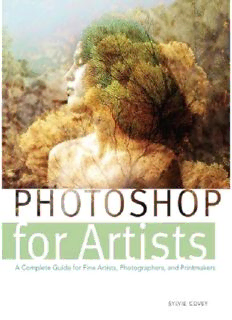
Photoshop for Artists PDF
Preview Photoshop for Artists
Copyright © 2012 by Sylvie Covey All rights reserved. Published in the United States by Watson-Guptill Publications, an imprint of the Crown Publishing Group, a division of Random House, Inc., New York. www.crownpublishing.com www.watsonguptill.com WATSON-GUPTILL is a registered trademark, and the WG and Horse designs are trademarks of Random House, Inc. The photo-etching Performances of the Heart was printed (in black & white) in Linea, Vol. 6, No. 2, Winter 2003. The digital prints Into the Sea 4b, Imagine a Land 3, and Wyoming 1 were printed in Linea, Vol. 14, No 2, Fall 2010. Library of Congress Cataloging-in-Publication Data Covey, Sylvie. Photoshop for artists / Sylvie Covey. p. cm. Includes bibliographical references and index. 1. Digital art—Technique. 2. Adobe Photoshop. I. Title. N7433.8.C69 2012 776—dc23 2011038161 eISBN: 978-0-8230-0672-4 v3.1 Acknowledgments There are many to thank for this book, first of all Candace Raney, executive editor at Watson-Guptill, who had the foresight to seek me out and understood the potential of this book, and a special thanks to the artist Nuri Taub, who many years ago encouraged me to take my first Photoshop class at the Fashion Institute of Technology. Many thanks to the Random House team, particularly Patrick Barb. Finally, I thank my friends and family who have encouraged me and gave me moral support, and I am particularly deeply grateful to the contributing artists who have generously shared their artwork for this endeavor. Contents Preface Introduction PART 1 Understanding the Vocabulary and Logic of Photoshop Workspace Overview Digital Basics Mastering Photoshop’s Tools for Artists PART 2 Tutorials for Drawing and Painting Digitally Drawing Digitally Painting Abstract Compositions Painting Digital Landscapes Painting with Wet Media Brushes Digital Oil Painting Using Digital Pastel and Dry Media Effects Painting Special Effects on Photographs Adding Custom Washes to Photographs Painting with Filters and Blends PART 3 Tutorials for Creating and Developing Fine-Art Digital Photography Making Basic Photo Corrections Using Blending Modes Replacing/Composing Scenery Applying New Adjustment Layer Effects Applying a Digital Double Exposure Making Creative Photomontages Changing a Photo from Color to Monochrome Adding Sepia and Other Tones Split Toning Solarization Adding HDR Effect Replacing Color Hand Coloring Photos Applying Halftone Patterns PART 4 Tutorials Combining Photoshop with Printmaking Photo-etching Making Color Separations in Lithography Creating Polyester Pronto Plate Lithography Mixed-Media Painting and Printmaking Making Digital Transfers Contributing Artists Index Preface Preface The process of making art is a continuous learning experience. As a printmaker, photographer, and painter, I am always fascinated by combining mediums and techniques—perhaps, it is an attempt to celebrate, transcend, or reverse the conventions of visual languages. In today’s world, we artists want to embrace new technologies, while still holding onto and combining them with more traditional methods of making art. New techniques keep on evolving. In the past, I used to print on film and make multiple exposures in a darkroom by sandwiching negatives in slide holders and I used liquid photo emulsions and chemistry on huge canvases and papers. I also printed collotypes with gelatin and cyanotypes with the sun and used tea and coffee—as well as many other more toxic chemicals—for toning. I was driven to learn all the languages of light and darkness. When I discovered Photoshop, however, my life began anew with colors. I believe that although we artists want to fly with new wings, see with new eyes, and hear new sounds, we still need somehow to produce a tangible testimony of what we see, hear, and feel. Combining old and new technologies allows this tangible world to exist in whole new dimensions of expression. Today, creating images digitally means that the possibilities for outputting them are infinite; it is the ultimate freedom. We still use our hands, our eyes, and our hearts, but with different tools, on different surfaces, and through different scales. There is no limit to what we can do. Sylvie Covey, Imagine a Land 5b (detail), digital print
Description: